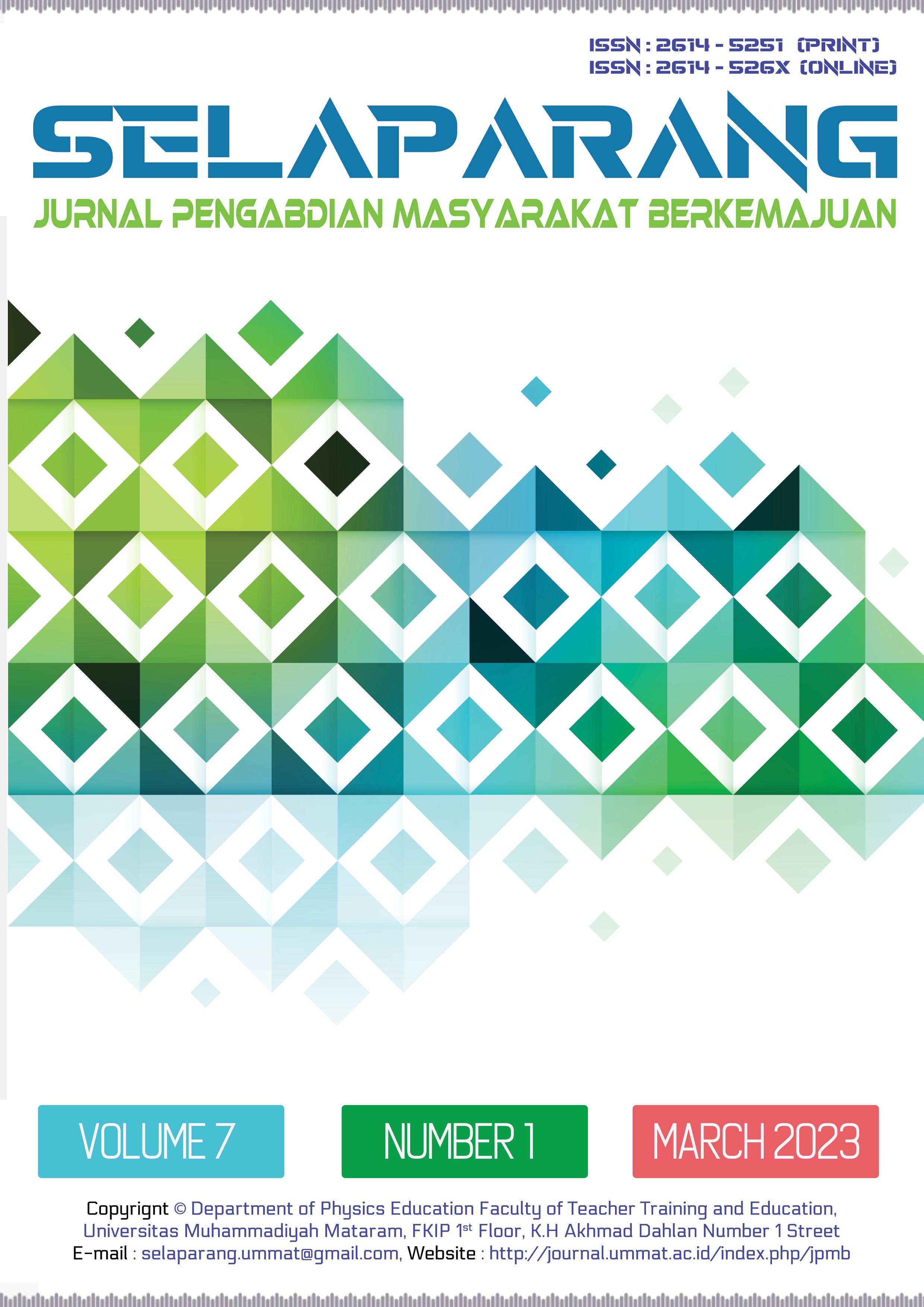PENDIDIKAN KESEHATAN TENTANG ALAT KONTRASEPSI IUD (SPIRAL) PADA PASANGAN USIA SUBUR DI WILAYAH KERJA PUSKESMAS LABUAPI
DOI:
https://doi.org/10.31764/jpmb.v7i1.13667Keywords:
health education, family planning, PUSAbstract
ABSTRAK
Keluarga Berencana (KB) merupakan program pemerintah untuk mengatur laju pertambahan penduduk di Indonesia dengan menggunakan metode kontrasepsi. Kontrasepsi dibagi menjadi dua jenis, yaitu Metode Kontrasepsi Jangka Panjang (MJKP) dan Non Metode Kontrasepsi Jangka Panjang (Non MJKP). Kegiatan pengabdian ini diikuti oleh 20 orang. Metode kegiatan dalam pengabdian ini akan melibatkan mahasiswa kebidanan Universitas Muhammadiyah Mataram sebanyak 6 mahasiswa. Pelaksanaan pengabdian dilakukan dalam tiga tahapan, yaitu: pembagian kuesioner pre test serta pemaparan materi, Tahap kedua yakni memberikan edukasi cara pemasangan alat kontrasepsi IUD (SPIRAL) dengan instrument leafleat. Tahap ketiga yakni tanya jawab dengan peserta pengabdian yakni pasangan usia subur (PUS) dalam hal ini ibu hamil dan ibu menyusui yang belum menggunakan alat kontrasepsi di Desa Labuapi. kesimpulan pengabdian yang dilakukan sebagai berikut hasil pretest dan posttest dari kegiatan yang dilakukan dapat dilihat terjadi peningkatan pengetahuan pasangan usia subur (PUS) dari nilai pretest dalam kategori kurang sebesar 45 % (9 orang) meningkat menjadi sebagian besar kategori pengetahuan baik sebesar 75 % (15 orang) pada saat posttest. Hal ini menunjukkan bahwa para peserta dapat menerima edukasi yang diberikan dengan baik.
Â
Kata kunci: pendidikan kesehatan; KB; PUS
Â
ABSTRACT
Family Planning (KB) is a government program to regulate the rate of population growth in Indonesia by using the contraceptive method. Contraception is divided into two types, namely Long Term Contraceptive Methods (MJKP) and Non Long Term Contraceptive Methods (Non MJKP). This dedication activity was attended by 20 people. The method of activity in this service will involve midwifery students at Muhammadiyah Mataram University as many as 6 students. The service is carried out in three stages, namely: distributing pre-test questionnaires and material presentation. The second stage is providing education on how to install the IUD contraceptive device (SPIRAL) with leafleat instruments. The third stage is question and answer with service participants namely couples of childbearing age (PUS) in this case pregnant women and nursing mothers who have not used contraception in Labuapi Village. the conclusion of the service carried out as follows is the results of the pretest and posttest of the activities carried out, it can be seen that there is an increase in the knowledge of couples of childbearing age (PUS) from the pretest value in the less category of 45% (9 people) increasing to the majority of good knowledge categories of 75% (15 people) at the posttest. This shows that the participants can receive the education provided properly.
Â
Keywords: health education; family planning; PUSReferences
Asria, W. and Nurullita, U. (2013) ‘Gambaran Pola Menstruasi Pada Akseptori Intra Uterin Device (Iud) Di Wilayah Kerja Puskesmas Kedungmundu Semarang’, Jurnal Keperawatan Maternitas, 1(Mei), pp. 28–36.
SDKI (2017) Survei Demografi dan Kesehatan Indonesia 2017.
Kemenkes RI (2014) ‘Pedoman Pelayanan Keluarga Berencana’, Direktorat Jenderal Bina Kesehatan Ibu dan Anak, 1(1), pp. 1–80.
Mulastin (2015) ‘Hubungan Sikap Ibu Tentang Alat Kontrasepsi Dalam Rahim Dengan Pemilihan Alat Kontrasepsi Dalam Rahim Di RSIA Kumalasari Pecangan Jepara’, Juoernal Kesehatan, 2 (1), pp. 14–20.
Nur, R. et al. (2021) ‘Factors related to the incidence of unmet need in couples of reproductive age in the working area of Marawola Health Center’, Gaceta Sanitaria, 35, pp. S176–S179. doi: 10.1016/J.GACETA.2021.10.019.
Priyani, E. S. (2015) ‘Pengaruh Penyuluhan Media Powerpoint dan Media Video terhadap Tingkat Pengetahuan Ibu tentang Kontrasepsi IUD Pasca Plasenta di Puskesmas Kasihan I Bantul’. Available at: http://lib.unisayogya.ac.id (Accessed: 8 February 2023).
Rayma, G. A. et al. (no date) ‘Hubungan Penggunaan Kontrasepsi Pil Dengan Berat’, pp. 1–10.
Saifuddin AB. Buku Panduan Praktis Pelayanan Kontrasepsi. Jakarta: Yayasan Bina Pustaka Sarwono Prawirohardjo; 2019
Shabana, A., P.m., D. and mahadeo Shinde (2014) ‘Knowledge of Contraceptives Methods andnAppraisal of Health Education among Married nWoman’, International Journal Of Science And Research, 3(3), pp. 584–590. Available at: httpwww.ijsr.netarchivev3i3MDIwMTMxMjQ3.pdf.
Simanjuntak, David. Akses Sosial Ekonomi dan Pelayanan Terhadap Kualitas Peserta KB. Majalah Kesehatan Masyarakat. 2016;24(11)
Sulistyawati, A. 2012. Pelayanan Keluarga Berencana. Jakarta: Salemba Medika.
BKKBN. (2020). Rencana Strategi 2020-2024 BKKBN.
Survey, H. (2013) ‘Demographic and health survey 2012. Gabonese Republic’, Enquete demographique et de sante 2012. Republique Gabonaise. Available at: http://dhsprogram.com/pubs/pdf/FR276/FR276.pdf.
Trimuriani, L. and Widyaningsih, H. (2017) ‘Hubungan Dukungan Suami Dengan Tingkat Kepuasan Pengguna Kontrasepsi Suntik Di Desa Bulungcangkring Jekulo Kudus’, PROSIDING HEFA 1st 2017, (2581–2270), pp. 248–253.
Wang, D. and Altmann, D. R. (2002) ‘Socio-demographic determinants of intrauterine device use and failure in China’, Human reproduction (Oxford, England), 17(5), pp. 1226–1232. doi: 10.1093/HUMREP/17.5.1226.
Downloads
Published
Issue
Section
License
The copyright of the received article shall be assigned to the journal as the publisher of the journal. The intended copyright includes the right to publish the article in various forms (including reprints). The journal maintains the publishing rights to the published articles.

Selaparang : Jurnal Pengabdian Masyarakat Berkemajuan is licensed under a Creative Commons Attribution-ShareAlike 4.0 International License.

